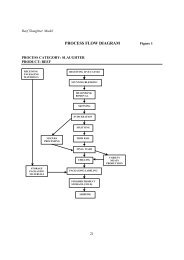Type of foodShellfishSoyaGlutenSesameseedsCeleryMustardSulphurdioxideWhat to look forPeople who are allergic to shellfish often need to avoid all types, <strong>in</strong>clud<strong>in</strong>gscampi, prawns, mussels <strong>and</strong> crab. Watch out for shrimp paste <strong>and</strong> oyster sauce<strong>in</strong> Ch<strong>in</strong>ese <strong>and</strong> Thai dishes.Soya comes <strong>in</strong> different forms, for example, tofu (or beancurd), soya flour <strong>and</strong>textured soya prote<strong>in</strong>. It is found <strong>in</strong> many foods, <strong>in</strong>clud<strong>in</strong>g ice cream, sauces,desserts, meat products <strong>and</strong> vegetarian products such as ‘veggie burgers’.People who have gluten <strong>in</strong>tolerance (also called Coeliac disease) need to avoidcereals such as wheat, rye <strong>and</strong> barley, <strong>and</strong> foods made from these. Wheat flouris used <strong>in</strong> many foods such as bread, pasta, cakes, pastry <strong>and</strong> meat products.Watch out for soups <strong>and</strong> sauces thickened w<strong>it</strong>h flour, foods that are dustedw<strong>it</strong>h flour before cook<strong>in</strong>g, batter <strong>and</strong> breadcrumbs.Sesame seeds are often used on bread <strong>and</strong> breadsticks. Sesame paste (tah<strong>in</strong>i) isused <strong>in</strong> some Greek <strong>and</strong> Turkish dishes, <strong>in</strong>clud<strong>in</strong>g houmous. Watch out forsesame oil used for cook<strong>in</strong>g or <strong>in</strong> dress<strong>in</strong>gs.People who are allergic to celery can react to celeriac (the root of the plant)<strong>and</strong> celery stalks <strong>and</strong> leaves. Celeriac <strong>and</strong> celery are sometimes used as an<strong>in</strong>gredient <strong>in</strong> salads <strong>and</strong> soups, or served as a vegetable. Watch out for celerysalt, which is used as a season<strong>in</strong>g <strong>in</strong> lots of foods, such as soups <strong>and</strong> meatproducts. Also look out for celery seeds, which are used as a spice.People who are allergic to mustard will react to any food that comes from themustard plant, <strong>in</strong>clud<strong>in</strong>g liquid mustard, mustard powder, the leaves, seeds <strong>and</strong>flowers, sprouted mustard seeds <strong>and</strong> mustard oil. Mustard is sometimes used <strong>in</strong>salad dress<strong>in</strong>gs, mar<strong>in</strong>ades, soups, sauces, curries <strong>and</strong> meat products.Some people w<strong>it</strong>h asthma can react to sulphur dioxide. This is used as apreservative <strong>in</strong> a wide range of foods, particularly meat products such assausages, soft dr<strong>in</strong>ks, <strong>and</strong> dried fru<strong>it</strong> <strong>and</strong> vegetables. Sulphur dioxide is alsofound <strong>in</strong> w<strong>in</strong>e <strong>and</strong> beer.What to do if th<strong>in</strong>gs go <strong>wrong</strong>If <strong>you</strong> th<strong>in</strong>k a customer is hav<strong>in</strong>g a severeallergic reaction:• Do not move them.• R<strong>in</strong>g 999 <strong>and</strong> ask for an ambulance w<strong>it</strong>ha paramedic straight away.• Expla<strong>in</strong> that <strong>you</strong>r customer could have anaphylaxis(pronounced ‘anna-fill-axis’).• Send someone outside to wa<strong>it</strong> for the ambulance.How to stop this happen<strong>in</strong>g aga<strong>in</strong>• Make sure that all <strong>you</strong>r staff underst<strong>and</strong> howimportant <strong>it</strong> is to check all the contents of adish if they are asked by someone who hasa food allergy.• Make sure <strong>you</strong> are keep<strong>in</strong>g <strong>in</strong>gredient <strong>in</strong>formationfor all ready-made products <strong>and</strong> that staff knowto check this.• Review the way that staff prepare a dish forsomeone w<strong>it</strong>h a food allergy – are they clean<strong>in</strong>geffectively first <strong>and</strong> us<strong>in</strong>g clean equipment?• Improve the descriptions on <strong>you</strong>r menu.• Tra<strong>in</strong> staff aga<strong>in</strong> on this safe method.• Improve supervision.Diary<strong>Wr<strong>it</strong>e</strong> <strong>down</strong> <strong>what</strong> <strong>went</strong> <strong>wrong</strong> <strong>and</strong> <strong>what</strong> <strong>you</strong> <strong>did</strong> <strong>about</strong> <strong>it</strong> <strong>in</strong> <strong>you</strong>r <strong>diary</strong>.DiaryCC7/09-06
Safe method:Physical <strong>and</strong> chemical contam<strong>in</strong>ationIt is very important to prevent objects<strong>and</strong> chemicals gett<strong>in</strong>g <strong>in</strong>to food.Safety po<strong>in</strong>tFollow the manufacturer’s<strong>in</strong>structions on how to use<strong>and</strong> store clean<strong>in</strong>g chemicals.Store clean<strong>in</strong>g chemicals separatelyfrom food <strong>and</strong> make sure they areclearly labelled.Keep food covered.Why?This is to prevent these chemicalsgett<strong>in</strong>g <strong>in</strong>to food.This helps to stop th<strong>in</strong>gs fall<strong>in</strong>g<strong>in</strong>to the food.Make sure <strong>you</strong> control pestseffectively. (See the ‘Pestcontrol’ safe method.)Make sure that any chemicals <strong>you</strong>use to control pests are used <strong>and</strong>stored <strong>in</strong> the correct way <strong>and</strong>clearly labelled.Always clear <strong>and</strong> clean as <strong>you</strong> go <strong>and</strong>take care to throw away packag<strong>in</strong>g,str<strong>in</strong>g etc. as soon as <strong>you</strong> remove <strong>it</strong>.(See the ‘Clear <strong>and</strong> clean as <strong>you</strong> go’safe method <strong>in</strong> the Clean<strong>in</strong>g section.)This is to stop <strong>in</strong>sects, dropp<strong>in</strong>gs etc. gett<strong>in</strong>g <strong>in</strong>to food, as well asprevent<strong>in</strong>g the spread of bacteria.This is to prevent these chemicals gett<strong>in</strong>g <strong>in</strong>to food.Keep<strong>in</strong>g surfaces clear <strong>and</strong> cleanwill help prevent chemicals <strong>and</strong>objects gett<strong>in</strong>g <strong>in</strong>to food, as wellas prevent<strong>in</strong>g the spreadof bacteria.Repair or replace any equipment orutensils that are damaged or haveloose parts.Loose parts may get <strong>in</strong>to foodby accident.It is a good idea to have a ruleof no glass <strong>in</strong> the k<strong>it</strong>chen.This helps to prevent broken glass gett<strong>in</strong>g <strong>in</strong>to food.Th<strong>in</strong>k twice!Avoid re-us<strong>in</strong>g food packag<strong>in</strong>g to store food. Often packag<strong>in</strong>g is designed to be used once w<strong>it</strong>h a certa<strong>in</strong> food,so <strong>it</strong> might not be safe to use <strong>it</strong> aga<strong>in</strong>, or to use <strong>it</strong> w<strong>it</strong>h a different food. If food packag<strong>in</strong>g is used <strong>in</strong> a way that <strong>it</strong>was not designed for, chemicals could transfer <strong>in</strong>to the food. Instead, use re-usable conta<strong>in</strong>ers that have beendesigned to store food (food grade).











